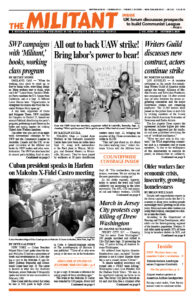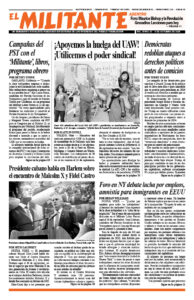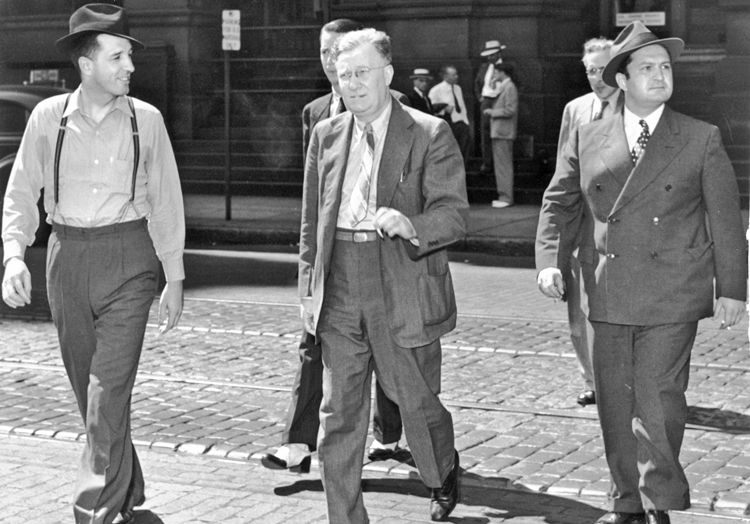One of Pathfinder’s Books of the Month for September is James P. Cannon As We Knew Him by Farrell Dobbs, Joseph Hansen, George Novack, Jean Tussey, Harry Braverman and 28 other contributors who knew and worked with him. The introduction is by Jack Barnes, national secretary of the Socialist Workers Party. From a traveling organizer for the Industrial Workers of the World, Cannon rose as a leader of the working-class left wing of the Socialist Party who was inspired by the 1917 Bolshevik Revolution in Russia. Joining with other revolutionists to found the Communist Party in the United States in 1919, he served on the executive committee of the Communist International in 1922. Expelled from the CP in 1928 for leading the fight to maintain Lenin’s proletarian internationalist course, he was a founding leader of the SWP. Copyright © 1976 by Pathfinder Press. Reprinted by permission.
A great contribution Jim made was the key role he played in founding the International Labor Defense in the 1920s. Two of the outstanding cases that were handled by the International Labor Defense under the leadership of Jim Cannon were the Mooney-Billings case and the case of Sacco and Vanzetti.
In the ILD there were certain ground rules established. For example, the rule that there be no factionalism in defense. Because what you’re defending — in addition to the individual defendant or defendants — is the democratic rights of the working class and its allies. From this derives that famous labor slogan “An injury to one is an injury to all.”
The principles of the ILD were, first, to defend all victims of capitalist oppression on our side of the class line. Second, not to take factional advantage of a defense case. That is, not to try to use it to push your own line and thereby alienate others who might otherwise join in the defense. Because the cardinal need is to defeat the capitalist frame-up.
Jim set these ground rules very well. After 1928, when those who went with [Joseph] Stalin took over in the CP, the ILD was turned into its opposite and violated every one of these rules. But the ground rules were set there. And they were picked up and improved and applied by the Trotskyist movement after Jim and his co-workers were expelled from the CP in 1928. …
Jim was one of the top leaders of the Communist Party. He had a big following. He was the head of the ILD. He was a member of the Political Committee of the party. And the CP was a big movement that had great promise, affiliated with the Third International and identified with the Russian revolution in the popular mind.
What did it cost to walk away from that? How dear was the truth at that point?
Jim was a delegate to the Sixth Congress of the Comintern in Moscow in 1928. By pure accident he got on the commission that handled the distribution of documents that had been translated.
[Leon] Trotsky’s criticism of the draft program that the Stalinists were submitting to the Sixth Congress came into this commission and was routinely translated. The Stalinist bureaucrats hadn’t quite tightened up all the holes yet. They had no intention of Trotsky’s document getting before the congress, but Jim got a copy of it.
He read it, and in essence two things came through to him. First, here were the answers to things that were beginning to puzzle him. As Jim described it to me — we had quite a conversation about this once — he said, “I make no pretense that I knew all the verities of the situation. I just had an instinct that not everything was the way it ought to be. But at the same time, who was I to challenge these guys who made a revolution? For all I, here in the United States knew, Stalin was still completely a Leninist. Who was I to challenge that?”
And he read the document and it began to give him some answers about some of the things that had made him uneasy. Having attained that, the second thing that came through to him was that he had better keep this in his pocket until he got out of Russia.
He knew instinctively that this was the way he had to go, because this was the direction in which the truth went — that is, the analysis and the programmatic projections set forth in Trotsky’s criticism of the draft program at the Sixth Congress.
That meant he had to turn his back on his chance to play a bigger and bigger role in the large and thriving Communist movement. And he was experienced enough to know doing that meant going into isolation.
And he made the break. …
That was the criterion that Jim Cannon set for himself when he came back from Moscow in 1928. He had found the truth about the profound developments taking place in the Soviet Union and hence in the Third International. And he had to serve that truth at all hazards. …
The Socialist Workers Party, under Jim’s central leadership, played a key role in backing Trotsky in the work of building the Fourth International.
For example, there was Jim’s trip to Europe in 1939. This was on the eve of World War II, when we had a big antiwar campaign going on. We were just getting ready to put the party’s paper out twice a week, and we were preparing to set up new party branches in Flint and Detroit.
Trotsky asked Jim to make a trip to France to help try to straighten out a few people — some of these “independent thinker” types. … He asked Jim to go because of his role as a central leader of the SWP, which had great standing in the world movement.
Despite all the things that were going on here, despite all the party-building opportunities facing us, Jim went to France, with the agreement of all of us.
This was the pattern that he set. The Socialist Workers Party is a thoroughgoing internationalist party — internationalist in its outlook; internationalist in the sense that we realize the necessity to collaborate in the closest possible way with revolutionaries throughout the world; and internationalist in the sense that we also realize that one of the prime criteria of internationalism is to build a revolutionary combat party in your own country.


